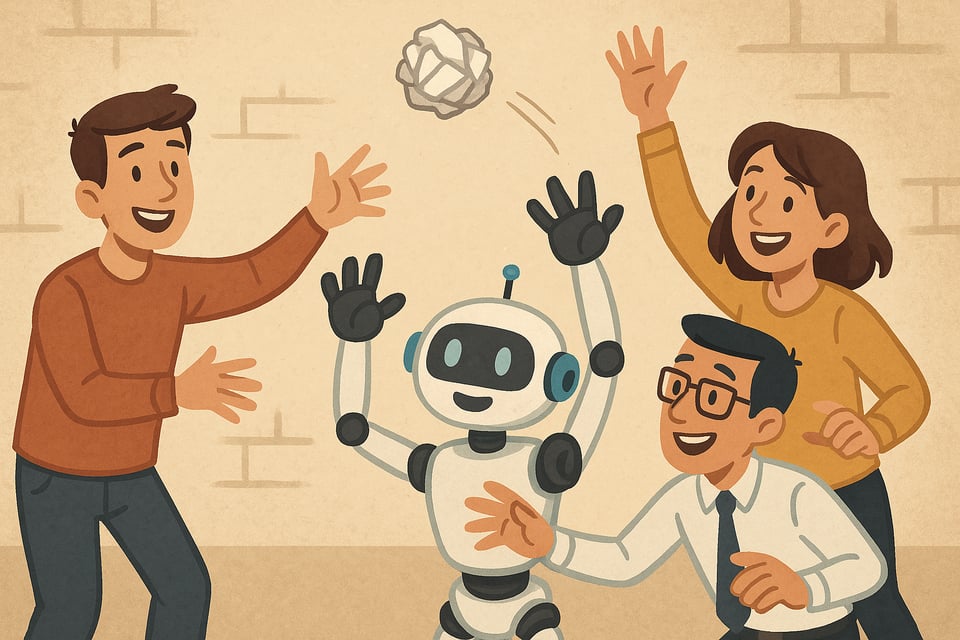Playing monkey in the middle with 🤖 Agents
GenAI is transforming my communication workflow, but raises new challenges in team collaboration.
GenAI - The communication multiplier
Getting on the GenAI bandwagon and incorporating it in my daily workflow has been a development in the last few months.
They do give you an edge in the work you do by helping your ideas be more accessible to different teams that engage with your work.
Clearly this space is evolving at rapid pace. There is too much noise around the future. The ethical component of AI and trends emerging in the overall economy are being postulated by everyone on their own usage of GenAI tools. I am not going to talk about any of these since far more knowledgeable people have written lucidly on these topics.
The future feels like that every work that is digital native and explicit in nature could be executed by a fine tuned agent.
The one scenario where it is helping me execute my own role better is communication. As I have previously mentioned, most of my job entails providing an explanation to the team. The GenAI tools are helping me slice and dice the message into different interpretations. The right interpretation is sent to the apt team. So, my job is taking an artefact and using GenAI to reformat into a version that fits best for my team members . It entails writing user stories, design brief, discovery document or proposals. Output is up and pace is fast.
Yet, it still falls short as the intended reader has access but feels uninitiated/overwhelmed to engage. When every team member can multiply documentation, what is the end state of the reader. Does time to review and time to create their own output have to be balanced out?
The fame Maker schedule, Manager schedule post of Paul Graham misses the collaboration aspect of work. If each team member can generate more work with the help of GenAI what is the time and cost of reviewing work for others in the team. This is important because time to generate the document is going down but the time to review (peer review) doesn’t follow the same trend.
We still need people to buy-into what we are going to do next and why is it worthy of their effort. Align on a approach and take the next steps.
My initial hypothesis was that GenAI and agents would solve co-ordination costs among team members(and organisation). Spending time implementing these tools in my workflow I am uncertain about the hypothesis now.
The analogy of self driving cars helps explain this better. Self driving cars are far more safer than humans as chances of fatalities(given no software glitches) is almost zero if every other car is also self driving. These cars will make us more efficient because people can do other things when driven around by self driving cars. Similarly, until agents do all the tasks that your team mates do at the same reliability level. Agents like self driving cars will help few increases their output and cost others by draining them with more things to review.
Its like playing the childhood game monkey in the middle. Picture a team handing off work among themselves and an agent in the middle is trying to catch it in order to replace the team member on whose hand-off agent grasps it.

This is how agents will start to become part of the team. The team member once in the middles stays in the middle.
Round up
In this round up , I will link to some of the posts that would help you make sense of the GenAI explosion.
You can consider this as a fan newsletter on what Jonah writes but I believe it is one of the most lucid written posts on the topic.
This one from Jonah is about limitation around agents. They are capable on replacing colleagues but how they handle discretion is the limiter.
Links that resonated
Sales in an another frontier I am tipping my hat in and this piece by Tomasz on challenger sales is simple and solid.
The case against conversational AI
My pet peeve against Chat interface is its too limiting. Julian proposes a more multi input approach.
Sign off
While agents are coming to disrupt how we work, the area of work still remains to be same. The field of legacy domains like logistics and agriculture will continue with same functions till we invent teleportation or humans no longer need to eat.
The pace of innovation in the end needs to enable a new form of doing the same work differently. GenAI is currently ramping speed but is doing the same work in a similar way by replacing the human. I am more curious to figure out novel functions AI can enable humans in new workflows in these domains.
Singing off till next time,
Vivek , having attention spans like the monkey in the middle.